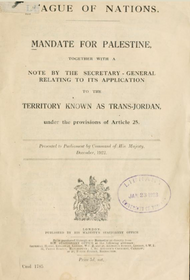British Mandate of Palestine facts for kids
Quick facts for kids League of Nations – Mandate for Palestine and Transjordan Memorandum |
|
 British Command Paper 1785, December 1922, containing the Mandate for Palestine and the Transjordan memorandum
|
|
| Created | Mid-1919 – 22 July 1922 |
| Location | UNOG Library; ref.: C.529. M.314. 1922. VI. |
| Signers | Council of the League of Nations |
| Purpose | Creation of the territories of Mandatory Palestine and the Emirate of Transjordan |
The Mandate for Palestine was a League of Nations mandate for British administration of the territories of Palestine and Transjordan, both of which had been conceded by the Ottoman Empire following the end of World War I in 1918. The mandate was assigned to Britain by the San Remo conference in April 1920, after France's concession in the 1918 Clemenceau–Lloyd George Agreement of the previously-agreed "international administration" of Palestine under the Sykes–Picot Agreement. Transjordan was added to the mandate after the Arab Kingdom in Damascus was toppled by the French in the Franco-Syrian War. Civil administration began in Palestine and Transjordan in July 1920 and April 1921, respectively, and the mandate was in force from 29 September 1923 to 15 May 1948 and to 25 May 1946 respectively.
The mandate document was based on Article 22 of the Covenant of the League of Nations of 28 June 1919 and the Supreme Council of the Principal Allied Powers' San Remo Resolution of 25 April 1920. The objective of the mandates over former territories of Ottoman Empire was to provide "administrative advice and assistance by a Mandatory until such time as they are able to stand alone". The border between Palestine and Transjordan was agreed in the final mandate document, and the approximate northern border with the French Mandate for Syria and the Lebanon was agreed in the Paulet–Newcombe Agreement of 23 December 1920.
In Palestine, the Mandate required Britain to put into effect the Balfour Declaration's "national home for the Jewish people" alongside the Palestinian Arabs, who composed the vast majority of the local population; this requirement and others, however, would not apply to the separate Arab emirate to be established in Transjordan. The British controlled Palestine for almost three decades, overseeing a succession of protests, riots and revolts between the Jewish and Palestinian Arab communities. During the Mandate, the area saw the rise of two nationalist movements: the Jews and the Palestinian Arabs. Intercommunal conflict in Mandatory Palestine ultimately produced the 1936–1939 Arab revolt in Palestine and the 1944–1948 Jewish insurgency in Mandatory Palestine. The United Nations Partition Plan for Palestine was passed on 29 November 1947; this envisaged the creation of separate Jewish and Arab states operating under economic union, and with Jerusalem transferred to UN trusteeship. Two weeks later, Colonial Secretary Arthur Creech Jones announced that the British Mandate would end on 15 May 1948. On the last day of the Mandate, the Jewish community there issued the Israeli Declaration of Independence. After the failure of the United Nations Partition Plan for Palestine, the 1947–1949 Palestine war ended with Mandatory Palestine divided among Israel, the Jordanian annexation of the West Bank and the Egyptian All-Palestine Protectorate in the Gaza Strip.
Transjordan was added to the mandate following the Cairo Conference of March 1921, at which it was agreed that Abdullah bin Hussein would administer the territory under the auspices of the Palestine Mandate. Since the end of the war it had been administered from Damascus by a joint Arab-British military administration headed by Abdullah's younger brother Faisal, and then became a no man's land after the French defeated Faisal's army in July 1920 and the British initially chose to avoid a definite connection with Palestine. The addition of Transjordan was given legal form on 21 March 1921, when the British incorporated Article 25 into the Palestine Mandate. Article 25 was implemented via the 16 September 1922 Transjordan memorandum, which established a separate "Administration of Trans-Jordan" for the application of the Mandate under the general supervision of Great Britain. In April 1923, five months before the mandate came into force, Britain announced its intention to recognise an "independent Government" in Transjordan; this autonomy increased further under a 20 February 1928 treaty, and the state became fully independent with the Treaty of London of 22 March 1946.

